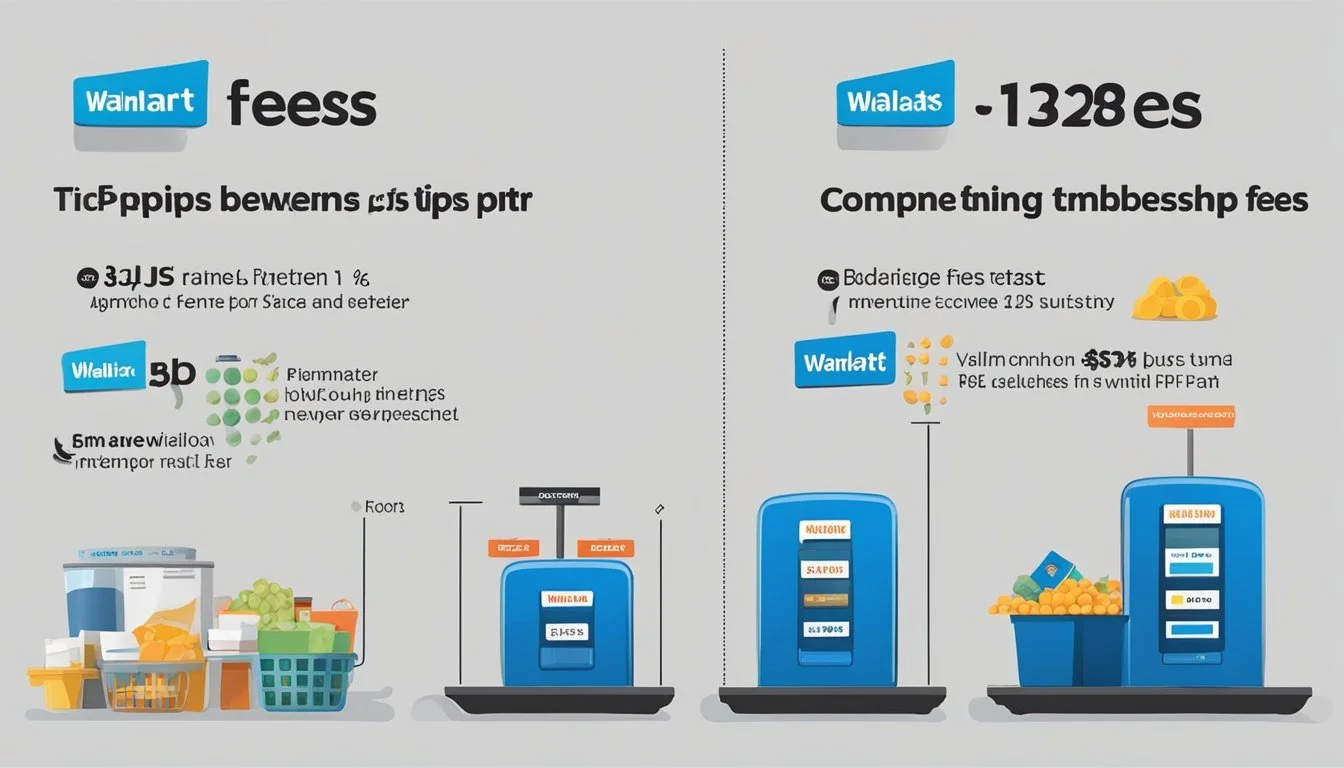Is Walmart Cheaper Than BJ's?
Comparing Prices and Value
Part of Our Grocery Store Guide with Details on Walmart Prices and BJ's Wholesale Club Prices
When discussing the shopping landscape, two retail giants often come to mind: Walmart and BJ's Wholesale Club. Both retailers cater to a wide variety of shopper needs but operate under different business models, which inherently impacts pricing structures and overall shopping experiences. Consumers look to stretch their dollars, particularly in an era where economic fluctuations and everyday expenses are a constant consideration. Walmart, known for its vast chain of supercenters, prides itself on offering competitive prices on a broad range of products without a membership requirement.
On the other side of the retail spectrum, BJ's Wholesale Club operates on a membership basis, providing bulk items and exclusive deals to its members. Shoppers who frequent BJ's value the savings that can be gained from buying in larger quantities, which often translates to lower prices per unit. However, the upfront cost of a membership fee can factor into the total savings equation, requiring shoppers to consider their shopping frequency and volume to determine if the membership yields net benefits.
Price comparisons between Walmart and BJ's can be intricate as they don't always align on an item-by-item basis; for instance, certain products may be cheaper at Walmart due to smaller packaging or Walmart's extensive purchasing power, while others could be less expensive at BJ's when bought in bulk. Quality, brand availability, and shopping convenience also play significant roles in shaping consumer preferences between the two retail experiences.
Comparative Price Analysis
In evaluating whether Walmart is more affordable than BJ's Wholesale Club, it's imperative to consider a range of factors, including the overall price range, differences in pricing by product category, and how the cost of national brands compares to store brands.
Overall Price Range
Walmart has established itself as a leader in offering competitive prices across a wide variety of products. Specifically, Walmart tends to offer lower prices compared to many grocery chains, including BJ's Wholesale Club. Reports indicate that on average, Walmart's prices can be up to 17% lower when compared to other major chains.
Analysis by Product Category
Fresh Produce: Walmart often has better pricing, largely due to their extensive supply chain efficiencies.
Packaged Goods: Comparisons show similar pricing between Walmart and BJ's, though bulk purchases at BJ's might edge ahead in savings.
Electronics: Walmart typically undercuts BJ's, offering lower regular prices and frequent discounts.
Brand vs. Store-Brand Pricing
National Brands: Walmart and BJ's price competitively here, but Walmart frequently offers discounts which can reduce the price further than BJ's regular rates.
Store Brands: Both retailers offer store-brand products at lower prices than national brands. Walmart's store brand, typically priced lower than BJ's equivalent, provides considerable savings for price-conscious shoppers.
Membership and Fees
When comparing Walmart and BJ's Wholesale Club, the core differences in their membership and fee structures are vital. Each retailer offers distinct benefits, costs, and reward programs that can influence a consumer's decision based on their shopping habits.
Membership Costs and Benefits
BJ's Wholesale Club operates on a membership model, offering two main tiers: a standard membership typically at $55 annually, and a premium tier at $110 per year. These memberships provide access to bulk goods, potential savings through available discounts, and additional in-store benefits. In contrast, Walmart does not require a membership, allowing customers to shop without an upfront fee, thus potentially better suiting those who prefer a pay-as-you-go approach.
Annual Fee Comparison
When directly comparing annual fees:
BJ's Wholesale Club: $55 - $110 (depending on tier)
Walmart: $0 (no membership required)
This differential places Walmart as an accessible option for immediate savings as there is no initial fee that must be recouped through store discounts or purchases.
Reward Programs
BJ's offers a variety of rewards and discount programs associated with its membership tiers, often linked to the percentage of money spent in their clubs. These can translate into a reduced effective cost of goods for customers who frequently shop in bulk. While membership-based reward programs are not part of the Walmart model, they do provide different forms of savings, such as rollback prices and special deals which are available to all customers without the need for a membership.
Bulk Buying and Savings Potential
When consumers shop at warehouse stores like Walmart and BJ's Wholesale Club, they often encounter the option to buy in bulk, which can lead to significant savings due to the lower price per unit and reduced frequency of purchase.
Advantages of Bulk Purchases
Shopping in bulk at warehouse stores is a practice that can save customers money in the long run. Stores like Walmart's Sam’s Club and BJ's Wholesale Club offer products in larger quantities, which typically sell at lower unit costs compared to smaller packages. This pricing strategy reflects the reduced handling and packaging costs, as well as the lower profit margins that warehouse stores are willing to accept.
Buying in bulk can be especially economical for households with high consumption needs or for items that have a long shelf life. The table below illustrates potential savings a consumer might expect:
Item Quantity Warehouse Store Price Price Per Unit Regular Store Price Price Per Unit Laundry Detergent 200 loads $19.99 $0.10/load $6.99 $0.35/25 loads Toilet Paper 36 rolls $18.97 $0.53/roll $8.13 $0.20/6 rolls
Bulk vs. Single Item Purchasing
While bulk purchases can offer savings, single item purchasing at regular retail establishments like Walmart may still be competitive on certain products. These stores often have sales or offer discounts for smaller quantities, making them an attractive option for customers who do not have the storage space for bulk products or who prefer to purchase a variety of brands.
Moreover, warehouse clubs often require memberships that come with a fee, whereas traditional retailers like Walmart do not. Consumers must consider whether the potential savings on bulk items are sufficient to offset this cost.
Shoppers should also be aware that not every item bought in bulk constitutes a saving in comparison to single item purchasing. Some products may have similar or better prices per unit during sales at regular retailers. It's essential for consumers to compare prices and consider how much of a product they reasonably consume to make the most financially beneficial choice.
Shopping Experience and Convenience
Selecting the right retail or wholesale option hinges on the convenience and experience provided by the store. Both Walmart and BJ's offer different experiences relating to store layout, online shopping options, and customer service, influencing the consumer's choice.
Store Layout and Navigation
Walmart stores are present virtually everywhere; they are recognized for their strategic placement and uniform layout. Shoppers can find a wide variety of goods ranging from groceries to electronics under one roof. The aisles in Walmart are clearly marked, and the store layout is consistent, which makes it easier for customers to navigate without wasting time.
BJ's Wholesale Club locations, although not as numerous as Walmart's, provide a vast space primarily dedicated to bulk items. The store's layout is such that it can accommodate larger quantities and packaging, which can be advantageous for those buying in bulk, but might require more time for customers to navigate due to the scale and variety of products.
Online Shopping Options
Walmart:
Robust online platform with a wide array of products.
Offers free shipping on orders over $35 for Walmart+ members.
Competes closely with Amazon in the e-commerce space.
BJ's Wholesale Club:
Online presence is significant with direct competition to other wholesale online options.
Provides online and app-based shopping experiences.
Free shipping may be available on select items for BJ’s members.
Customer Service Comparison
Walmart's customer service is designed to handle a high volume of customers efficiently. They provide multiple services like in-store pickup and easy returns, attempting to match the convenience of online retail giants like Amazon.
BJ's customer service focuses on delivering value to its members, offering a more personalized interaction. BJ's, similar to other wholesale clubs, might have fewer staff members available, which could impact the speed of service during peak hours. However, the staff is geared towards providing assistance for bulk purchases and membership services.
Product Selection and Availability
Walmart and BJ's Wholesale Club offer extensive product selections, each catering to different consumer needs. Availability can vary by location, impacting the shopping experience.
Grocery and Perishables
Walmart provides a vast array of grocery items ranging from meat to dairy products. The store is known for its wide selection of both conventional and organic produce, ensuring shoppers have access to fresh ingredients. Walmart's large purchasing power often means they have a consistent supply of perishable goods.
Meat: Varied selection including beef, poultry, and seafood.
Dairy Products: Includes milk, cheese, yogurt, and more.
Organic: Selection of organic fruits, vegetables, and packaged goods.
Produce: Assortment of fresh fruits and vegetables.
Non-Food Items
On the non-food front, Walmart excels with a diverse inventory that includes toilet paper, glasses, and diapers. They stock a multitude of brands and product types to accommodate a broad customer base. Under non-food items, both everyday essentials and specific non-grocery categories are covered.
Toilet Paper: Multiple brands and pack sizes available.
Glasses: Ranges from reading glasses to prescription eyewear.
Diapers: Wide selection catering to different ages and sizes.
Extra Services and Features
When examining Walmart and BJ's Wholesale Club, one must consider the variety of extra services and features each retailer offers aside from their core retail operations. These services, which typically include gas stations, pharmacies, and optical departments, enhance the shopping experience for consumers and can influence their choice of retailer.
Gas Stations and Gasoline Sales
Walmart operates a significant number of gas stations at its store locations. Shoppers can often find competitive gasoline prices at Walmart gas stations, potentially lower than at BJ's. Additionally, Walmart frequently offers a discount on gasoline as part of its Walmart+ membership program.
BJ's Wholesale Club also operates gas stations with discounted gasoline prices for its members. BJ's members can benefit from exclusive fuel savings which can compound with other in-store promotions.
Pharmacy and Prescriptions
Walmart's pharmacy offers a comprehensive suite of services, including prescription refills, immunization, and health screenings. Walmart also has a "$4 generic prescription program" which covers a variety of medications at a lower cost, providing accessible health solutions.
BJ's has an in-store pharmacy service as well, where members can have their prescriptions filled. However, BJ's may not offer an extensive generic prescription program like Walmart's, potentially influencing the cost savings on medications for shoppers.
Optical Department
Walmart's optical department includes vision centers that offer eye exams, glasses, sunglasses, and contact lens sales. Walmart's optical services are known for being reasonably priced, making vision care affordable for many consumers.
BJ's Wholesale Club similarly provides optical services to its members. BJ's Optical provides professional eye care services, including eye exams by licensed optometrists and a selection of eyewear at member pricing, which can be a cost-effective option for eye health needs.
Customer Demographics and Shopping Behavior
Understanding the demographics and shopping behavior of customers can provide insights into how Walmart and BJ's Wholesale cater to different segments of the market.
Target vs. Typical Shopper Profile
Walmart:
Income Range: A significant portion of Walmart shoppers, about 25%, reportedly earn between $50,000 - $100,000 annually, and 20% earn $25,000 - $50,000. These statistics show that Walmart appeals to a diverse income bracket, with a strong appeal particularly to low and middle-income individuals.
Shopping Expertise: Walmart attracts customers who seek convenience and competitive prices across a wide range of products, from grocery to electronics.
BJ's Wholesale:
Income Range: The BJ's shopper typically may have a similar or slightly higher income range but also looks for bulk purchases to maximize savings.
Business Customers: BJ's, being a wholesale club, attracts small business owners looking for advantages in bulk buying for their business needs.
Shopping Patterns and Frequency
Walmart:
Customers visit Walmart's stores frequently, with 255 million weekly visits reported across their expansive network of stores.
BJ's Wholesale:
BJ's Wholesale customers might shop less frequently but purchase in larger volumes due to the nature of bulk buying.
Both retailers have cultivated their respective customer bases by understanding and responding to shopping patterns, whether it's the frequency of single-item purchases at Walmart or the larger, bulk transactions at BJ's.
Geographical Presence and Accessibility
When examining the geographical reach and convenience of Walmart and BJ's Wholesale, one should consider both their positioning across regions and the density of their store locations.
East Coast vs. Midwest Layering
On the East Coast, BJ's Wholesale has a strong presence, offering extensive accessibility to consumers with numerous stores. Walmart, with its global footprint, maintains a robust presence across both the East Coast and Midwest, challenging BJ's concentrated East Coast layering. The Midwest is not left behind in Walmart's strategy as they, alongside competitors like Target and regional player Meijer, ensure a competitive atmosphere.
Store Locations and Density
Walmart operates a vast network across the United States. Their store count massively exceeds BJ's, which means that for most consumers, Walmart is more geographically accessible. In the context of store density:
Walmart: Over 4,700 stores in the U.S.
BJ's Wholesale: Around 216 locations, primarily focused on the East Coast.
The sheer difference in numbers indicates that Walmart offers more locations, hence higher accessibility, potentially outweighing the presence of chains like Lidl in some regions. This distribution of locations allows Walmart to serve a wider customer base, spanning from urban centers to rural areas.
Brand and Corporate Strategies
Walmart and BJ's Wholesale Club implement distinctive corporate strategies to secure their market positions and influence consumer perception. These strategies are designed to highlight their competitiveness and align with their CEOs' vision, often disseminated through company podcasts and other media.
Market Positioning and Competitiveness
Walmart, recognized by its stock ticker symbol WMT, has strategically positioned itself as a cost leader in the supermarket industry. By offering a wide array of products like coffee, bread, pasta, and wine at competitive prices, Walmart appeals to a diverse customer base. The company sustains its competitive advantage by leveraging a combination of large-scale purchasing, an extensive distribution network, and advanced supply chain logistics.
BJ's Wholesale Club differentiates itself by operating on a membership-based model, providing bulk groceries and consumer goods at lower prices, which appeals to value-focused consumers. The brand’s strategy revolves around offering significant savings to its members, maintaining customer loyalty and presenting itself as an economical alternative to traditional supermarkets.
CEO's Vision and Company Podcasts
The CEO's vision for both companies significantly influences their corporate strategies. At Walmart, the leadership focuses on innovation and customer satisfaction. By staying ahead of retail trends and adapting to market changes, the CEO ensures that Walmart maintains its status as an industry leader.
BJ's Wholesale Club's CEO shapes the brand's direction by emphasizing the importance of value and member experience. Their corporate podcasts and other media channels provide insights into company values, upcoming initiatives, and industry perspectives. These media outlets are pivotal in crafting the narrative around the brand's strategy, fostering a connection with customers and stakeholders.
In these ways, both companies articulate their unique strategies and leadership vision, reinforcing their brand identities and competing effectively in the retail sector.
Economic Factors and Market Dynamics
When assessing the pricing strategies of Walmart and BJ's, it is imperative to consider the economic factors and market dynamics that influence retail pricing. These include the impact of inflation on the cost of goods, and how revenue models and profit margins determine the prices set by these retail giants.
Effects of Inflation on Pricing
Inflation has a direct impact on retail pricing strategies as it affects the cost of goods sold (COGS). For example, NPR reported a 23% average price increase on several dozen items at Walmart since mid-2019. In a high inflation environment, both Walmart and BJ's have to navigate the increased costs of procurement while ensuring their pricing remains competitive to attract budget-conscious consumers.
Revenue Models and Profit Margins
The revenue models of Walmart and BJ's influence their profit margins and, subsequently, their pricing. Walmart's large scale often enables it to leverage economies of scale, resulting in potentially lower prices for consumers despite inflation. BJ's Wholesale Club, which requires membership, may operate with a different revenue model that factors in membership fees, possibly permitting lower margins on product sales. This difference can affect the pricing each store offers to customers.
Conclusion
When comparing Walmart and BJ's Wholesale Club, shoppers will find differences in pricing and the shopping experience. Walmart is renowned for its low prices and extensive inventory, which includes a plethora of items from groceries to electronics. Its one-stop shopping model is beneficial for consumers looking to save on both money and time.
BJ's, on the other hand, offers competitive prices and has the edge with its own exclusive brands that can lead to additional savings. Members often find deals at BJ's that are not available at Walmart, particularly when purchasing in bulk. BJ's also provides exclusive savings opportunities throughout the year.
Pricing on Individual Items: Walmart often has lower prices for smaller quantities, which is ideal for consumers not looking to buy in bulk.
Bulk Savings: BJ's can offer better savings on bulk items, with exclusive brands that undercut Walmart's prices.
Both retail giants present a value proposition in their own right, with the ultimate decision coming down to the consumer's shopping preferences and needs. For those who require larger quantities and are already BJ's members, they may find that BJ's edges out Walmart in terms of value. Yet for everyday shopping without the commitment of a membership, Walmart stands out as a more accessible choice.
More about Walmart
Is Walmart Cheaper Than Albertsons?









